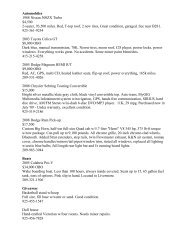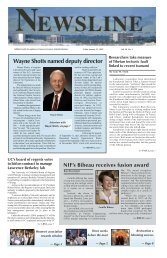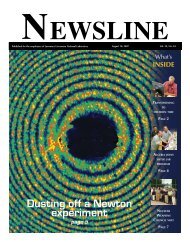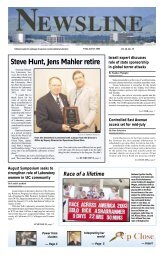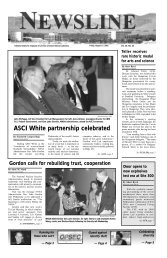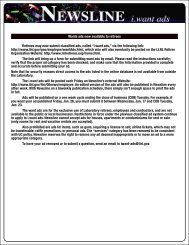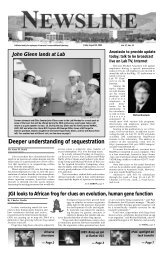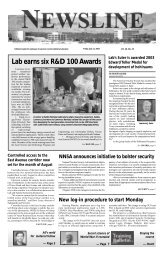A year of successes for national security missions - NEWSLINE ...
A year of successes for national security missions - NEWSLINE ...
A year of successes for national security missions - NEWSLINE ...
You also want an ePaper? Increase the reach of your titles
YUMPU automatically turns print PDFs into web optimized ePapers that Google loves.
Friday, January 9, 2004 Newsline 3<br />
A recap <strong>of</strong> events and achievements in 2003<br />
Editor’s note: Below is a<br />
month-by-month recap <strong>of</strong> the<br />
major events <strong>of</strong> 2003, yet<br />
another <strong>year</strong> in which the Laboratory<br />
lived up to its motto <strong>of</strong><br />
“science in the <strong>national</strong> interest.”<br />
This is a selection <strong>of</strong><br />
events and achievements.<br />
Science & technology<br />
Areplica <strong>of</strong> the Clementine satellite,<br />
which spent 70 days orbiting the<br />
moon in 1994 mapping and photographing<br />
the lunar surface, finds a<br />
new home in the Smithsonian National<br />
Air & Space Museum in Washington<br />
DC. Livermore helped develop<br />
the backup sensor components <strong>for</strong><br />
Clementine.<br />
The Laboratory’s new Homeland<br />
Security Organization Acting Director<br />
Wayne Shotts establishes six programs<br />
charged with developing technologies<br />
to reduce U.S. terrorism vulnerabilities<br />
in different areas.<br />
The National Ignition Facility and the Physics and<br />
Advanced Technologies directorates unveil the Eyeglass<br />
5-meter diffractive lens, the world’s largest lens<br />
to date, which is made up <strong>of</strong> 72 precisely aligned glass<br />
panels.<br />
Raging wildfires destroy the Mount Stromlo<br />
Observatory in Canberra, Australia, home <strong>of</strong> the historic<br />
Great Melbourne Telescope, halting all Laboratory<br />
astronomy research conducted there.<br />
U.S. Secretary <strong>of</strong> Energy Spencer Abraham<br />
announces that the United States will rejoin the Inter<strong>national</strong><br />
Thermonuclear Experiment Reactor (ITER),<br />
a project aimed at demonstrating the scientific and<br />
technological feasibility <strong>of</strong> fusion energy.<br />
People<br />
Dr. Edward Teller celebrates his 95th birthday.<br />
Mary Kimberly Lawrence, better known as<br />
“Molly,” widow <strong>of</strong> Berkeley and Livermore Lab<br />
founder and namesake Ernest O. Lawrence, dies Jan.<br />
6 at age 92.<br />
Edward M. Rubin, an inter<strong>national</strong>ly known<br />
geneticist and medical researcher, is named director<br />
<strong>of</strong> the Joint Genome Institute.<br />
Bob Schanilec and Donald Harrison <strong>of</strong> Lab TV<br />
receive <strong>national</strong> and inter<strong>national</strong> recognition <strong>for</strong> their<br />
video productions.<br />
More than 25 teachers from throughout Cali<strong>for</strong>nia<br />
attend a one-day workshop on photonics co-sponsored<br />
by the Lab, the Inter<strong>national</strong> Society <strong>for</strong> Optical<br />
Engineering and the Cali<strong>for</strong>nia Photonics Consortium.<br />
Operations<br />
Director Michael Anastasio unveils a list <strong>of</strong> 10<br />
“values” to help guide the Laboratory in the fulfillment<br />
<strong>of</strong> <strong>missions</strong> and responsibilities. (See box at right.)<br />
The UC Regents reaffirm their commitment to<br />
continue oversight <strong>of</strong> the labs.<br />
TeamNIF reaches a new safety milestone <strong>of</strong> two<br />
consecutive <strong>year</strong>s without a lost workday. That translates<br />
to 2,559,803 total work hours (more than 1,200<br />
worker <strong>year</strong>s) without one worker losing a single day<br />
due to injury.<br />
Science & technology<br />
Lab and UC Berkeley researchers find that semen<br />
quality in adult men declines, suggesting that age plays<br />
a greater role in male fertility rates than previously<br />
thought.<br />
Stewart Fallon <strong>of</strong> the Lab’s Center <strong>for</strong> Accelera-<br />
Researchers from the National Ignition Facility and the Physics and Advanced Technologies<br />
directorates display the Eyeglass 5-meter diffractive lens to Lab employees.<br />
Laboratory<br />
Values<br />
Passion <strong>for</strong> mission<br />
Integrity and responsible stewardship <strong>of</strong> the public<br />
trust<br />
Simultaneous excellence in science<br />
& technology, operations and business practices<br />
Balancing innovation with disciplined execution<br />
Teamwork while preserving individual initiative<br />
Intense competition <strong>of</strong> ideas with respect <strong>for</strong><br />
individuals<br />
Treating each other with dignity<br />
A high-quality, motivated work<strong>for</strong>ce with diverse<br />
ideas, skills and backgrounds<br />
Rewarding and recognizing per<strong>for</strong>mance<br />
Commitment to the collective success <strong>of</strong> the Laboratory<br />
tor Mass Spectrometry, in collaboration with<br />
researchers from Australian National University and<br />
the Australian Institute <strong>of</strong> Marine Science, find evidence<br />
that sediment from run<strong>of</strong>fs has increased sharply<br />
in the 150 <strong>year</strong>s since the first Europeans settled along<br />
the Australian coast, negatively affecting the Great<br />
Barrier Reef.<br />
Livermore scientist Tom Isaacs, a member <strong>of</strong> the<br />
National Academy <strong>of</strong> Sciences’ National Research<br />
Council, gives a progress report on the Yucca Mountain<br />
nuclear waste repository at the 2003 meeting <strong>of</strong><br />
the American Association <strong>for</strong> the Advancement <strong>of</strong> Science.<br />
Using advanced computing capabilities, Lab engineer<br />
Robert Ferencz illustrates some <strong>of</strong> the issues that<br />
arise when mitigating the effects <strong>of</strong> a bomb blast on<br />
infrastructure during a presentation at the 2003 meeting<br />
<strong>of</strong> the American Association <strong>for</strong> the Advancement<br />
<strong>of</strong> Science.<br />
People<br />
The Columbia Space Shuttle crashes upon reentry<br />
into the Earth’s atmosphere, taking the lives <strong>of</strong><br />
Rick Husband, Dave Brown, William McCool,<br />
Michael Anderson, Kalpana Chawla, Laurel Clark and<br />
Ilan Ramon, all friends and colleagues <strong>of</strong> Lab employ-<br />
ees and <strong>for</strong>mer astronauts<br />
Tammy Jernigan and Jeff<br />
Wis<strong>of</strong>f.<br />
Laboratory scientists<br />
Claire Max and Ellen<br />
Raber are two <strong>of</strong> nine<br />
awardees inducted into<br />
the Alameda County<br />
Women’s Hall <strong>of</strong> Fame.<br />
Former Secretary<br />
<strong>of</strong> State George Schultz<br />
visits the Lab <strong>for</strong> a full day<br />
<strong>of</strong> briefings, including a<br />
tour <strong>of</strong> NIF.<br />
The Lab’s Engineering<br />
Directorate sponsors<br />
a one-day session,<br />
titled “Optical Engineering<br />
at the Lawrence Livermore<br />
National Lab,” as part <strong>of</strong><br />
the Inter<strong>national</strong> Optical<br />
Engineering Society’s<br />
Photonics West 2003 Conference.<br />
The Federal Laboratory<br />
Consortium <strong>for</strong><br />
Technology Transfer<br />
grants the Extreme Ultraviolet<br />
Lithography<br />
(EUVL) project an Excellency<br />
in Technology Transfer<br />
Award <strong>for</strong> transferring to industry technology that<br />
will lead to microprocessors that are tens <strong>of</strong> times faster<br />
than today’s most powerful chips and create memory<br />
chips with similar increases in storage capacity.<br />
The American Association <strong>for</strong> the Advancement<br />
<strong>of</strong> Science names <strong>for</strong>mer Deputy Director <strong>for</strong> Science<br />
& Technology, Jeff Wadsworth, and Craig Smith, a<br />
nuclear engineer and project leader in the Energy and<br />
Environment Directorate, 2002 AAAS fellows.<br />
Robert Lawrence, son <strong>of</strong> Lab co-founder Ernest<br />
Lawrence, and his wife, Eleanor, tour the Laboratory<br />
and receive briefings on the Forensic Science Center,<br />
Medical Technologies, Homeland Security, the<br />
See 2003, page 4<br />
QUOTABLES<br />
QUOTABLES<br />
On the Lab<br />
“Our founders, Ernest Lawrence and Edward<br />
Teller, imprinted on us the Lab’s genetic code<br />
— a code that has withstood the test <strong>of</strong> time<br />
<strong>for</strong> those 50 <strong>year</strong>s.”<br />
– Glenn Mara, deputy director, Operations<br />
“The archives is not a place to warehouse old<br />
records, but a living collection that provides<br />
in<strong>for</strong>mation Lab employees need to do their<br />
jobs.”<br />
– Maxine Trost, Lab archivist<br />
“Livermore is a great place to hold a workshop<br />
like this because the Lab can draw together a<br />
wide variety <strong>of</strong> views under the umbrella <strong>of</strong><br />
academic discussion. It’s harder <strong>for</strong> government<br />
to do that.”<br />
– Paul Longworth, deputy NNSA administrator, on<br />
CGSR’s “Atoms <strong>for</strong> Peace” workshops and conference<br />
“Credibility is hard to earn, but very easy to<br />
lose, so let’s hang on to it.”<br />
– Michael Anastasio in state <strong>of</strong> the Lab<br />
“Good <strong>security</strong> <strong>for</strong> the Laboratory is good<br />
<strong>security</strong> <strong>for</strong> the community.”<br />
– Dave Leary, on limited access to East Avenue




